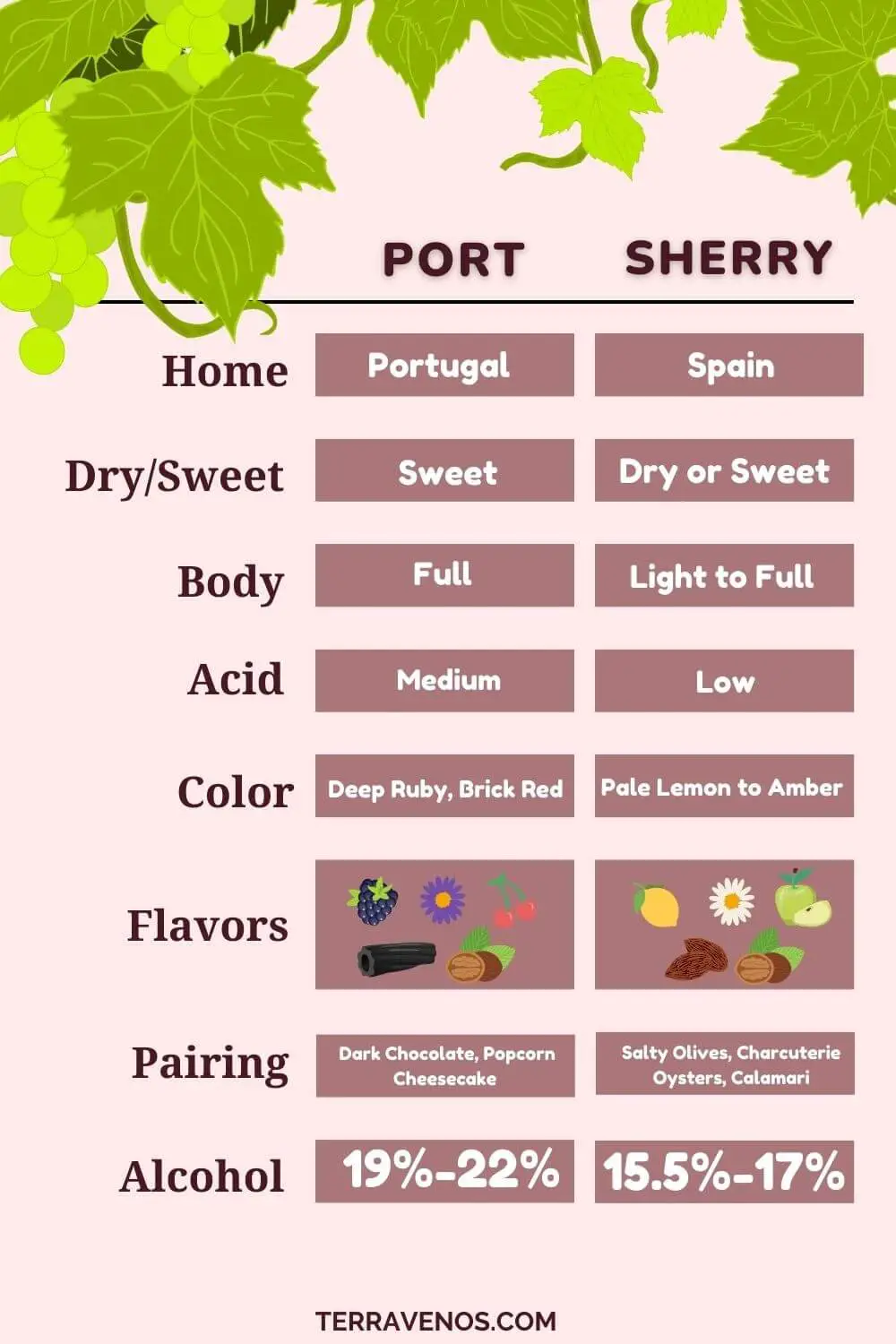
If you’re wondering about the differences between Sherry and Port, then you’re in the right place!
Port and Sherry are fortified wines but use different grapes and winemaking methods. Port is sweet, full-bodied, with dark fruit, licorice, and leather. Sherry is dry or sweet, low acid, with citrus and nuts. Port is higher in alcohol than Sherry. Both wines come in different styles.
You’ll want to understand the basic differences between Sherry and Port before buying a bottle. These two wines have their extremes!
- Are Port and Sherry Wines the Same?
- Sherry vs Port: Where Are they Made?
- Sherry vs Port: Wine Grapes
- Sherry vs Port: Wine Production
- Port vs Sherry: Wine Styles
- Which Is Better Sherry or Port?
- Which Wine Is Stronger? Sherry or Port?
- Is Sherry or Port Sweeter?
- Port vs Sherry: Wine Pairing
- Cooking: Can I Use Port Instead of Sherry
- Final Thoughts – Are Port and Sherry Wines the Same? Nope!
- Thirsty for More?
Are Port and Sherry Wines the Same?
Port and Sherry wines aren’t the same. Check out this quick side-by-side comparison chart of Sherry and Port.
You’ll notice that not only are these wines made in different countries, but they also have distinctive flavors.
Helpful Tip: Fortified wines are relatively uncommon for most average wine drinkers, so I put together this post that goes into more detail on the differences between fortified and unfortified wines.
Sherry vs Port: Where Are they Made?
Where’s Sherry Wine Made?
Check out this map to see Sherry’s birthplace:
Sherry wines are made in the southwestern region of Spain in Andalusia, right up against the Atlantic Ocean, specifically from the region between the towns of Jerez de la Frontera, Sanlúcar de Barrameda, and El Puerto de Santa María.
Wine production in the region dates back several millennia to the time of the Phoenicians.
Where’s Port Wine Made?
Explore this map of the Douoro Valley:
Port wines are made in Portugal’s Douro Valley region, a steeply ravined river valley with vineyards hugging the mountainsides. The Douro Valley extends West to East, with hotter vineyard locations further inland.
Harvest happens from September through October. Warmer sites are harvested earlier than cooler sites.
Sherry vs Port: Wine Grapes
Sherry Grape: Palomino
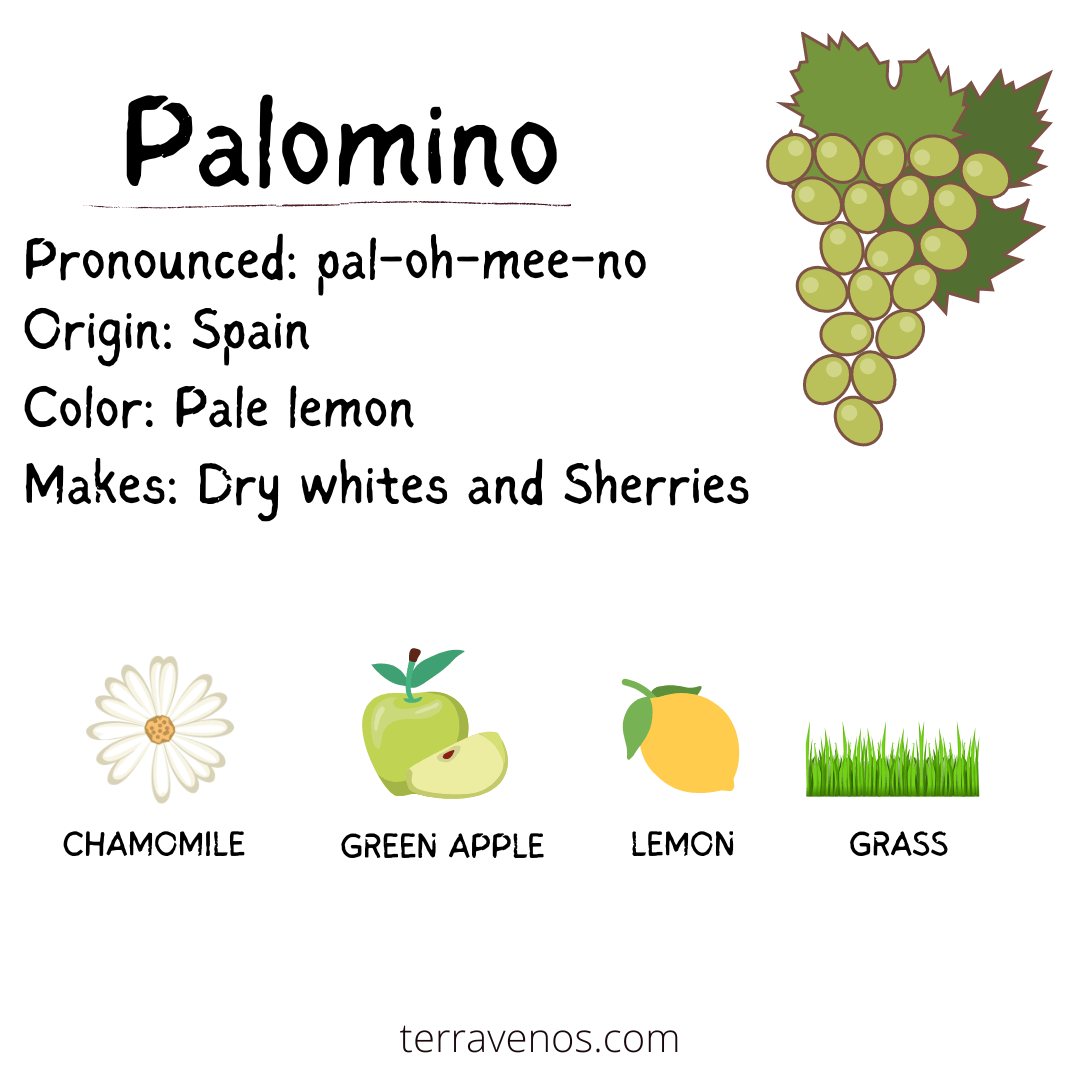
The vast majority of Sherries are made out of the white Palomino grape. Some Sherries are made out of Moscatel and Pedro Ximenez grapes, but those are in the minority and used for naturally sweet Sherries.
The white Palomino grape is a low acid, relatively neutral grape, meaning that it doesn’t have the pronounced aromatics you get from a Sauvignon Blanc or a Riesling, for example.
This neutral flavor profile means that Palomino can act like a blank canvas for the winemaker to introduce nuanced flavors and complexities into the wine through the winemaking process.
Port Wine Grapes
Over 100 different grape varieties are permitted in Port wine production, but only 5 are widely used:
- Touriga Franca grapes
- Touriga Nacional grapes
- Tinta Roriz grapes
- Tinta Barroca grapes
- Tinta Amarela grapes
- Tinto Cao grapes
- Sousao grapes
Each grape adds a different character to the final blend, whether it’s body, tannin, color, or flavor.
Port producers will decide which grapes and how much they want of each in their Port wines.
Sherry vs Port: Wine Production
One of the key differences between Port and Sherry wines comes down to how these two wines are crafted. Each follows traditional winemaking distinctive to their regional legacies.
Helpful Tip: Fortified wines are relatively uncommon for most average wine drinkers, so I put together this post that goes into more detail on the differences between fortified and unfortified wines.
How Is Sherry Wine Made?
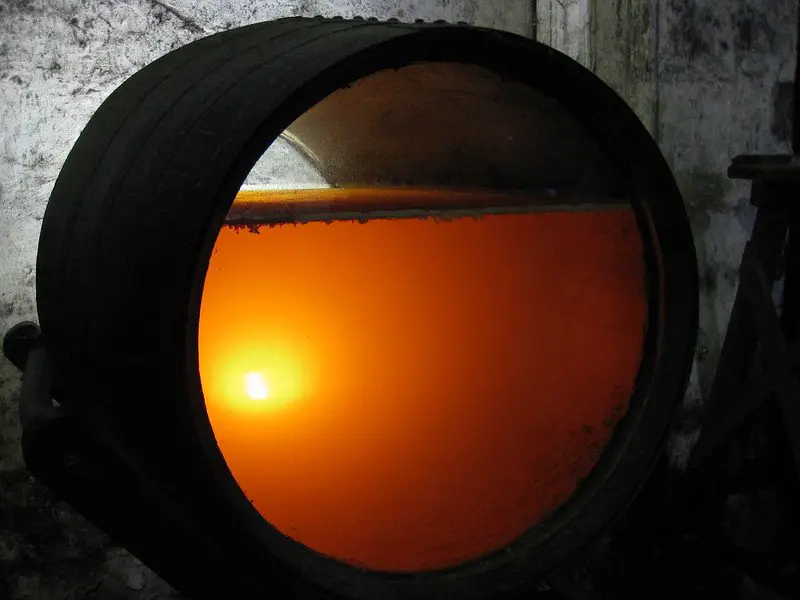
Sherry wines start out as a dry white wine. The winemaker ferments the grape juice fully to around 12% abv.
This white wine then goes through a classification process that determines whether the wine is further aged under a layer of yeast to produce a fresh, delicate style of Sherry, or whether it will be aged in partially filled barrels for a richer, oxidative style of sherry.
- Sherries that are destined for the first style of wine get fortified to 15%-15.5% abv.
- Sherries destined for the second, oxidative style, get fortified to 17% abv.
Regardless of the style, Sherry aging takes place in large warehouses where the temperature is carefully controlled, called bodegas.
Helpful Tip: Sherry winemaking is unnecessarily complicated, so here’s a post that covers everything you need to know about how Sherry wine is made.
Sweet styles of Sherry wine, like Cream or Pale Cream, are sweetened by adding concentrated grape juice before bottling.
Most Sherry wines (and most Port wines) are a blend of vintages. But Vintage Port is one of the finest wines in the wine world if you have the budget for it.
Helpful Tip: Here’s a post that explains what a vintage is in wine and why it’s important.
How Is Port Wine Made?
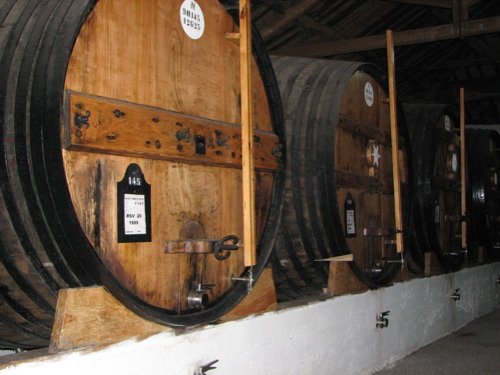
After the grapes are harvested, they are crushed and fermentation starts. The key to Port fermentation is maximizing extraction.
Jargon Alert: Extraction is a winemaking term that refers to extracting flavors, color, and tannin from the grape juice. This is done by continuously pushing the grape skins down in the tank where they’re fermenting. The more the winemaker submerges the grape skins, the more flavors, tannins, and color they’ll extract.
In typical winemaking, extraction can last 2-4 weeks. Extraction for Port lasts a maximum of 2 days.
This process is quick for Port because the winemaker will add spirit, called aguardente (77% alcohol by volume), to the fermenting wine. Like Madeira, this stops the fermentation leaving a sweet, fortified wine that’s 19%-22% alcohol by volume.
Port’s then aged in huge oak barrels, called balsieros, or smaller oak barrels, called pipas. This allows the wine and spirit to integrate.
The winemaker will blend different lots of Port together to craft their wine. Most Ports are a blend of different vintages and grapes (Sherry’s just a different blend of vintages, but almost always 100% Palomino grape wine).
Helpful Tip: Here’s a better post that goes into how Port wines are made.
Port vs Sherry: Wine Styles
Port versus Sherry: Color

Port wines will always be a deep ruby or brick red and garnet color (unless it’s a white or rosé, but those are rare).
This is thanks to the red grapes used in the winemaking process and the heavy extraction. Over time, the color will fade, but still be noticeably red.
Sherry wines can be pale lemon (just like a regular white wine) if they’re made in a fresh style, like Fino or Manzanilla Sherries. Sherry wines can also be amber or even brown if they’re aged oxidatively.
Port versus Sherry: Body
Port wines will taste fuller-bodied comparatively thanks to their sweetness and high alcohol level. Sherry wines come in different styles but usually come across as light or medium in body.
Fun Wine Fact: Alcohol adds body and mouthfeel to wine. High alcohol wines will taste fuller-bodied when you drink them.
Dry Sherry wines will taste lighter than Port. Sweet styles, like Cream Sherry, can be fuller bodied thanks to their higher sugar and alcohol level. But even Cream Sherry is lower in alcohol than Port.
Sherry versus Port: Taste
Sherry wines are low in acid. Dry Sherries will have chamomile, citrus peel (lemon), green almond, praline, and walnut. Some styles may even have a yeasty note thanks to biological aging.
Port wines are medium acid, medium to high tannin sweet wines with layers of jammy red and black fruit, like strawberry, blackberry, black cherry, and plum. Expect purple flower notes, licorice, and even leather and chocolate.
Which Is Better Sherry or Port?
If you like heavy red wines with rich black and red fruit, then Port is better. If you have an open mind to dried citrus peel, nuts, and varnish, then you may discover a love of Sherry.
Which Wine Is Stronger? Sherry or Port?
Port will taste stronger and more alcoholic with more burn than Sherry. This is because Port uses a greater volume of spirit to fortify the wine. Sherry wines can smell stronger than Port thanks to their oxidative aging process that brings out varnish, praline, and walnut.
Is Sherry or Port Sweeter?
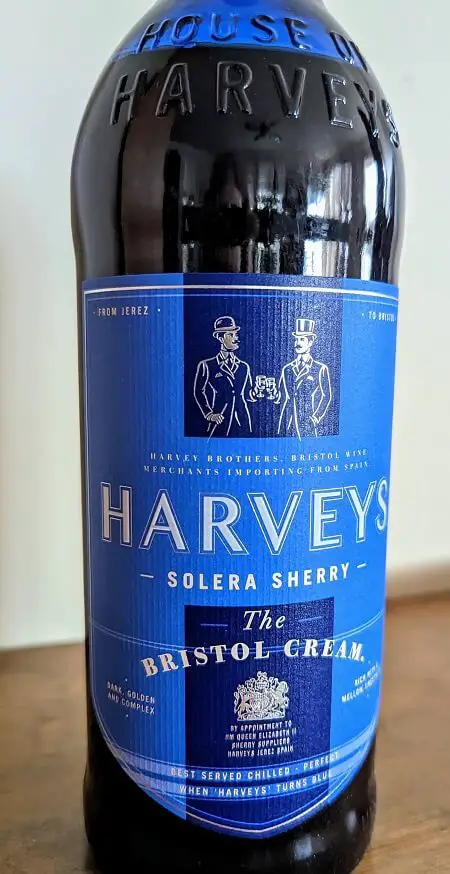
Port is always sweet. 100% of the time. Sherry can be dry or sweet. Look for the word “cream” on the label if you want a sweet Sherry. Port will taste sweeter than Cream Sherries thanks to its rich, full body and higher alcohol.
Here’s a list of different Port and Sherry styles you’ll run into:
Port Styles
- Ruby Port
- Tawny Port
- Reserve Ruby Port
- Reserve Tawny Port
- Colheita
- Vintage Port
Helpful Post: Here’s an overview of common Port FAQs.
Sherry Styles
- Fino Sherry (Dry)
- Manzanilla Sherry (Dry)
- Amontillado Sherry (Dry)
- Oloroso Sherry (Dry)
- Pale Cream Sherry (Seet)
- Medium Cream Sherry (Sweet)
- Cream Sherry (Sweet)
Helpful Post: As I wrote earlier, Sherry’s complicated. Here’s a post that goes into the differences among these different Sherry styles – they’re significant, so it’s worth reading about before going and buying a bottle.
Port vs Sherry: Wine Pairing
5 Easy Sherry Wine Pairing Ideas
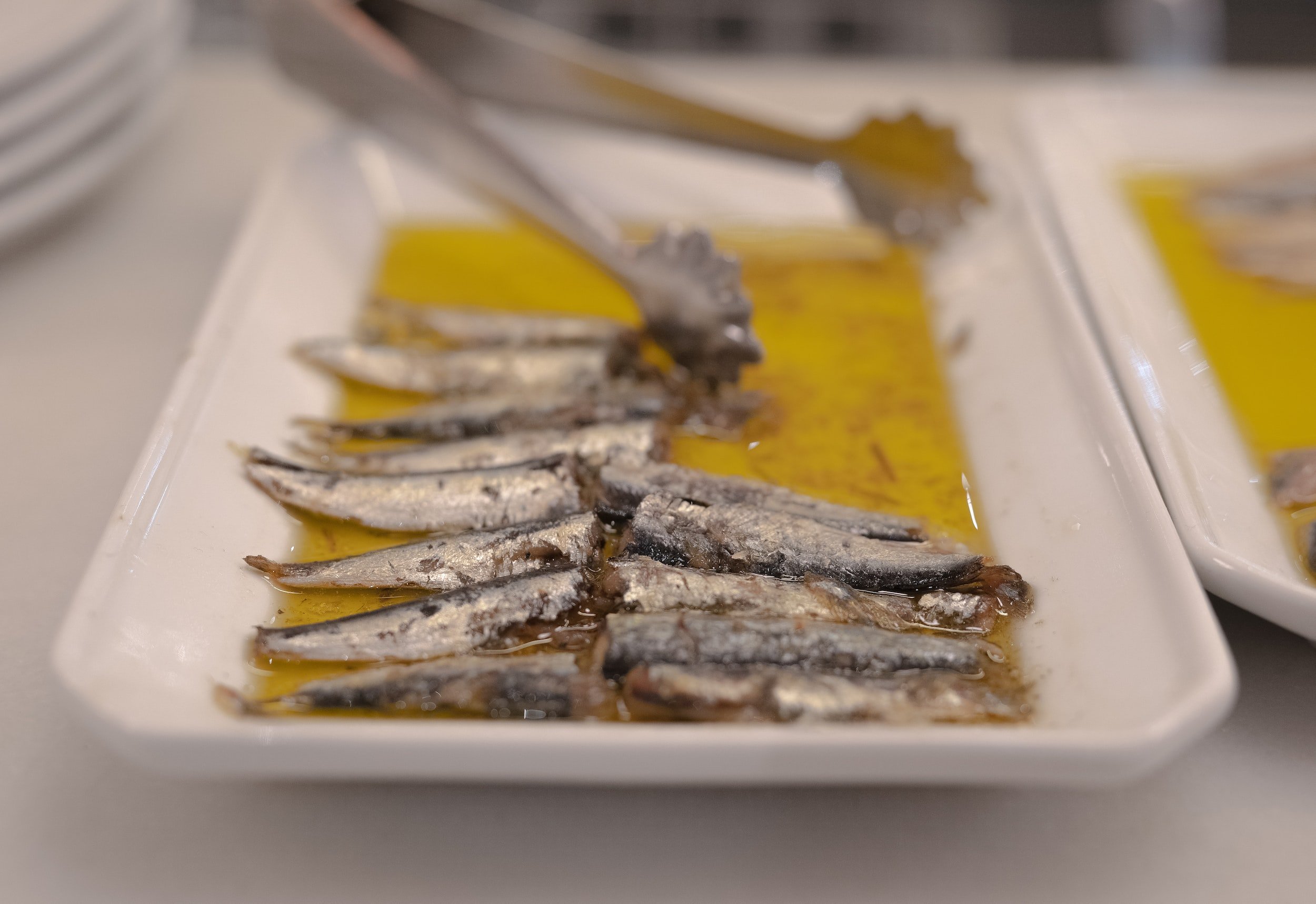
Sherry wines are more nuanced and subtle than Madeira. Their delicate flavors go well with salt and fat. Here are 5 great Sherry wine pairings:
- Tapas: Sherry is a classic partner to Spanish tapas, particularly salty snacks like olives, almonds, and charcuterie. Chorizo, anyone?
- Briney Seafood: The crisp and delicate citrus notes of Sherry balance the salty flavors of seafood like clams, calamari, and shrimp. Try Sherry with sushi!
- Hard Cheeses: Think Manchego. You’ll find nutty and earthy flavors and aromas in both wine and cheese. Yum!
- Hearty soups and stews: Lentil soups, roasted vegetable soups, and minestrone soups all have the savory quality you’re looking for when paired with Sherry wine.
- Lox and Bagels: A personal favorite, get your smoked salmon, toasted bagels, and capers ready for a beautiful pairing of salt, earth, seafood, and wine.
5 Fabulous Port Wine Pairing Ideas

Port’s sweet wine profile dominates your palate, so you’ll want to pair accordingly.
- Steak with a Port Reduction: Use some of your Port to create a reduction sauce for steak. Enjoy with a glass of Port.
- Salted Caramel and Tawny Port: Caramel brings salt an nuttiness, both of which are great wine combos, but the Port will take this pairing to the next level.
- Popcorn and Ruby Port: Ruby Port is a simpler, uncomplicated version of Port. Pour yourself a glass and enjoy with some popcorn.
- Dark Chocolate: Like Madeira, chocolate will always pair well with Port wine, but go for dark chocolate – that’s where the magic is!
- Salted Nuts: Salted almonds and walnuts have been recommended pairings for Port wine for over a hundred years. There’s a reason!
Helpful Tip: If you’re just getting started out with wine, I put together this helpful overview of food with wine pairing to get you started. Side note – I spend just as much time thinking about food with wine pairing as I do deciding what I’m going to eat every night. Utter hedonism. What can I say?
Helpful Tip: Here’s a rundown of what wine glasses you should be using when drinking Port wines (and also creative substitutes if you don’t have a full wine bar).
Cooking: Can I Use Port Instead of Sherry

You can substitute Port for Sherry when cooking, but keep in mind the different flavor profiles before you do. Port has sugar as well as red and black fruits and tannin. Think of Port as a sweet red wine.
Ask Yourself: Would your dish work with the red wine flavors?
Sherry brings delicate citrus and nutty flavors to your dish. For sauces and marinades, substituting Port for Sherry can fundamentally alter the profile of your recipe.
A better substitute for Sherry is regular white wine.
Sherry and Port Wine Flight Experiment
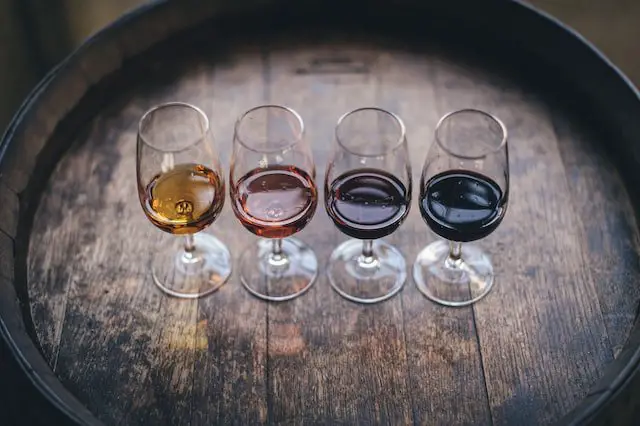
Go find yourself:
- 1 bottle of Ruby Port
- 1 bottle of Fino Sherry
Ruby Ports are widely sold and relatively inexpensive. Fino Sherries are widely sold and relatively inexpensive, too!
How to do your Sherry and Port tasting:
- Get 2 wine glasses
- Pour a small amount of Sherry in glass 1
- Pour a small amount of Port in glass 2
Helpful Tip: Remember! These are high-alcohol fortified wines. You only want a small pour.
- Look at the color of each wine over a white piece of paper
- Swirl and smell each of the wines
- Taste the Sherry first
- Taste the Port second
Helpful Note: The Sherry will be lighter in body and dry, so you’ll want to drink it first. If you drink the Port first, you’ll likely find the Sherry hard to taste and off-putting. Go ahead and experiment. But be warned!
Think about the following questions:
- What does each wine look like?
- What does each wine smell like?
- How does each wine feel in your mouth (the Sherry should feel lighter)
Final Thoughts – Are Port and Sherry Wines the Same? Nope!
Sherry and Port are two fortified wines with long winemaking traditions. Their distinctive winemaking processes make the differences between Port and Sherry stark opposites when it comes to taste, body, and mouthfeel. If you’re looking for a full-bodied, rich, sweet wine, then Port is a good choice. But if you’re looking for a lighter fortified wine with delicate layers of citrus, herbs, and nuts, then Sherry may be more your style.
Thirsty for More?
You may be interested in this post on how to pick out a good fortified wine.
And here’s a great overview of the 10 types of fortified wines – all worth exploring!
Here’s a post that compares Sherry vs Madeira and a second post on Port vs. Madeira – also helpful if you’re getting into fortified wines.




